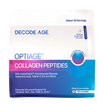Muscular dystrophy encompasses a group of genetic disorders leading to muscle weakness. Degenerating muscle experiences a loss of both mitochondria and a crucial cofactor called nicotinamide adenine dinucleotide (NAD+). NMN (Nicotinamide Mononucleotide) enhances muscle health and reduces degeneration by boosting NAD+ levels within muscle cells. NAD+ levels also enhance mitochondrial activity, alleviating energy stress in muscle cells. This has the potential to improve and retain muscle function, potentially slowing the progression of the disease.
What is Muscular Dystrophy (MD)?
Muscular dystrophy (MD) is a collective term for a group of genetic conditions that lead to the gradual weakening and deterioration of skeletal muscles. These occur due to abnormal genes (mutations) that interfere with protein production required to build healthy muscles. There are over 30 types, each differing in the age at which symptoms appear, their severity, and the specific muscles affected. All forms of MD worsen over time as muscles degenerate and lose strength, often resulting in the eventual inability to move.
Certain types of MD also impact other body systems such as the heart, lungs, gastrointestinal system, endocrine glands, spine, eyes, brain, or other organs. Individuals with MD may experience complications like difficulty swallowing. Importantly, MD is not contagious, and it cannot be triggered by injury or activity.
How does Muscle Dystrophy Affect Muscles?
Muscles are made of numerous fibres, each comprising cells enveloped by an outer membrane. The muscle fibres forming individual muscles are connected by connective tissue. The activation of muscles occurs when a signal is transmitted from the brain through the spinal cord and peripheral nerves to the neuromuscular junction. At this junction, acetylcholine initiates a series of events leading to muscle contraction.
Within the muscle fibre membrane lies the dystrophin-glycoprotein complex, a set of proteins that prevent damage during muscle contraction and relaxation. Study says that When this protective membrane is compromised, muscle fibres release the protein creatine kinase and accumulate excess calcium, resulting in damage and eventual death of the muscle fibres. This process leads to progressive muscle degeneration. Some forms of muscular dystrophy arise from defects in the dystrophin-glycoprotein complex, while others result from issues in the surrounding connective tissue or the expression of harmful gene products in muscle fibres.
Causes of Muscular Dystrophy
The majority of muscular dystrophy cases result from mutations in genes that impact muscle proteins. Typically, these mutations are inherited, but there are instances where they occur spontaneously. In such cases, the affected individual's descendants can inherit these spontaneous mutations.
Most forms of muscular dystrophy follow three distinct inheritance patterns: autosomal dominant, autosomal recessive, and X-linked recessive. Autosomal dominant inheritance occurs when one parent with MD passes the mutation, while autosomal recessive requires mutations from both parents. X-linked recessive inheritance involves the transmission of the genetic change through the X chromosome, affecting males more often, and females being carriers unless they inherit the mutation from both parents.
Signs and Symptoms
The symptoms, age of onset, and prognosis vary depending on the specific type of muscular dystrophy a person has. While the symptoms can differ among the various types, the primary indication is muscle weakness and related issues. Different muscle groups and body parts may be affected by each type, and the symptoms generally worsen progressively. Symptoms related to muscles and movement may encompass muscle atrophy/ degeneration, difficulty in walking, climbing stairs, or running, an abnormal walking gait (such as waddling or toe walking), stiff or loose joints, persistent muscle, tendon, and skin contractures, spasticity, and pain. Additional symptoms may involve fatigue, difficulty swallowing (dysphagia), heart-related problems like arrhythmia and heart failure (cardiomyopathy), scoliosis, breathing difficulties, intellectual disabilities, and learning disorders.
The severity and progression of symptoms can vary, with some forms of muscular dystrophy exhibiting mild symptoms that develop slowly over time, while others lead to rapid muscle weakness and increased physical disability.
Potential of NAD+ boosters in mitigating the effects of muscular dystrophy

In degenerating muscles, the loss of both mitochondria and NAD+ is a critical aspect. NAD+ is essential for cellular energy metabolism, and its depletion can contribute to the progression of muscle disorders. The increase in enzymes that consume NAD+ and the decline in biosynthetic enzymes responsible for NAD+ production further worsen the situation.
NR, a form of vitamin B3, and precursor to NMN has shown promising therapeutic effects in various muscle disorders. While it doesn't address the underlying genetic defects, NR has been found to enhance mitochondrial abundance and function in mitochondrial myopathies. It has also demonstrated benefits in heart failure models by improving survival time, inducing autophagy, and decreasing the mitochondrial unfolded protein response.
In a study conducted by Zhang et al in 2018, mouse models of Duchenne muscular dystrophy were treated with Nicotinamide Riboside (NR), an NAD+ booster. Remarkably, within just one week, the mice showed restored endurance, improved stem cell function, and a reduction in muscle wasting. Notably, the positive effects of NAD+ boosters extend beyond skeletal muscle, as demonstrated in various organs such as the liver, heart, and eyes. Additionally, the treatment was associated with enhanced stem cell function, indicating a broader impact on tissue regeneration.
In another study led by Ryu et al, it was revealed that replenishing NAD+ significantly enhanced muscle function in mouse models with muscular dystrophy. This improvement was attributed to an increase in the number of mitochondria, elevated levels of muscle structural proteins, and a reduction in inflammation. When administered preventively, NAD+ replenishment led to heightened muscle protein levels, reduced damage, decreased plasma creatine kinase levels, and improved grip strength. The restoration of NAD+ levels in mice or worms with disease-like degenerating muscles demonstrated consistent improvements in muscle function through increased mitochondrial content, enhanced muscle structural proteins, and a reduction in inflammation.
These studies collectively provide valuable insights into the potential of NAD+ boosters in mitigating the effects of muscular dystrophy. The observed improvements in muscle function, mitochondrial abundance, and structural proteins, as well as the reduction in inflammation, suggest that NAD+ replenishment could be a promising therapeutic strategy for treating muscle disorders.
Bottom Line
The loss of mitochondrial function and energy impacts the progression of muscular dystrophies leading to muscle degeneration or wasting. The observed enhancements in muscle function, increased mitochondrial abundance, elevated levels of structural proteins, and the reduction in inflammation collectively indicate that NAD+ replenishment holds promise as a viable therapeutic strategy for treating muscle disorders in mouse models.
The encouraging outcomes in these preclinical studies provide hope for translating these findings into human applications. If the positive effects observed in mice can be replicated in human trials, NAD+ boosters may prove to be effective in mitigating the symptoms of muscular dystrophy (MD) in humans. This potential therapeutic area offers optimism for developing interventions that can improve the quality of life for individuals affected by MD, although further research and clinical trials are necessary to validate and translate these promising results to human contexts.
FAQs
1) What causes muscular dystrophy?
In most cases, muscular dystrophy is caused by gene mutations that are responsible for healthy muscle structure, strength, and function. These mutations lead to muscle weakness and progressive disability. It usually develops after inheriting a faulty gene from one or both parents.
2) What is the life expectancy of a person with muscular dystrophy?
The average life expectancy of a person with muscular dystrophy is 18-25 years, but with treatment, the life span can be extended to 30 years.
3) What is the age of onset for muscular dystrophy?
The age of onset for muscular dystrophy symptoms usually occurs between the ages 5 and 60 years but it begins in teenage years. Its severity increases and varies from person to person.
4) What does muscular dystrophy do to the brain?
Duchenne muscular dystrophy affects the connectivity within the brain. It causes memory problems intellectual disabilities, cognitive difficulties, and personality changes.
5) Is muscular dystrophy autosomal dominant?
Yes, muscular dystrophy can be an autosomal dominant or autosomal recessive disorder. It affects the muscles and other parts of the body like the heart, eyes, etc.,
6) Does muscular dystrophy get worse?
The condition of muscular dystrophy gets worse as it passes down from parents to offspring. As age increases, the symptoms tend to increase gradually causing symptoms like excess tiredness or personality problems.
7) Is muscular dystrophy a disability?
Yes, muscular dystrophy can come under disability. Most of the patients suffering from muscular dystrophy are confined to a wheelchair. The Social Security Administration recognizes muscular dystrophy as an impairment. The individuals whose symptoms meet the eligibility criteria can qualify for the social security disability.
8) Is muscular dystrophy an autoimmune disease?
No, it is not an autoimmune disease. It is a progressive genetic disease in which mutated genes affect healthy muscle function. It is a group of inherited diseases in which the voluntary muscles get weak.
9) What's the difference between muscular dystrophy and myotonic dystrophy?
Muscular dystrophy (MD) is a collection of nine genetic disorders characterized by the gradual weakening and deterioration of muscles involved in voluntary movement. Among these, myotonic dystrophy (DM) is the most prevalent type in adults and is believed to be one of the most widespread forms across all age groups.
References
- https://www.ninds.nih.gov/health-information/disorders/muscular-dystrophy
- https://nyulangone.org/conditions/muscular-dystrophy/types
- https://www.ncbi.nlm.nih.gov/books/NBK556092/
- https://www.nichd.nih.gov/health/topics/musculardys/conditioninfo/causes
- https://my.clevelandclinic.org/health/diseases/14128-muscular-dystrophy
- https://doi.org/10.1016%2Fj.cmet.2017.11.002
- https://doi.org/10.1126%2Fscitranslmed.aaf5504


















Leave a comment
All comments are moderated before being published.
This site is protected by hCaptcha and the hCaptcha Privacy Policy and Terms of Service apply.